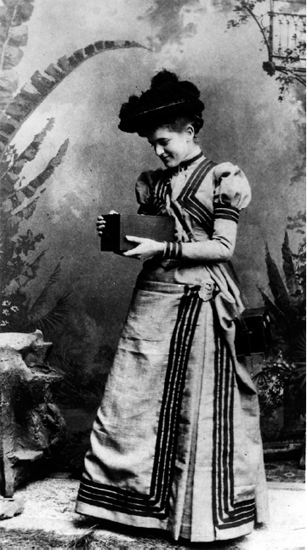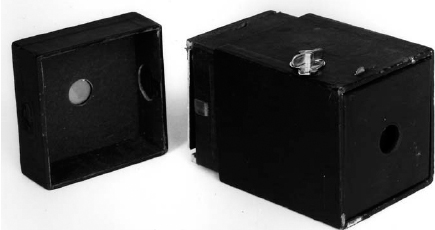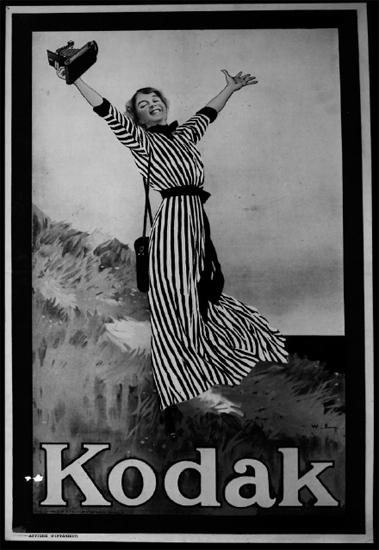CHAPTER 1
The History of the Medium Format
“Medium format” as it is defined today—“to categorize the film formats between 35 mm and the larger view camera formats 4 × 5 in. and up—”is frequently considered quite new.
But photography actually started with the medium format. The daguerreotype plates used in the 1840s were 6 1/2 × 8 1/2 in. large. But since silver and copper, the components of these plates, were very expensive, the image often did not cover the full size of the plate, so the plates were split into smaller sections (1/2 to 1/16) such as 2 3/4 × 3 1/4 in., 2 1/8 × 3 1/4 in., or 1 5/8 × 2 1/8 in. Judging from the large number of photographic images that have survived from this time, the 2 3/4 × 3 1/4 in. “medium format” was the most popular.
Roll film, which forms the basis for the design of the modern medium format camera, appeared in 1888 when George Eastman introduced the first camera with the Kodak name. The camera was factory loaded with roll film for 100 exposures, and the entire camera had to be returned to Eastman for processing the finished roll of film and for reloading. The image size on the negative was a 2 1/2 in. circle.
The medium format took a giant step toward becoming the most popular film format for years to come when the Box Brownie appeared on the market in 1900. Eastman hoped that with the price tag of $1, the camera would fulfill his dream to bring photography to every schoolchild. The Brownie also ushered in today’s most popular medium format, the 2 1/4 in. square, which was produced in the Box Brownie on a cartridge of 117 roll film with six exposures. The cost was 15 cents.

In one of the early photographic promotion pieces, the Kodak camera was shown handheld to emphasize its compact size. Photographers simply aimed these early “handheld” cameras at the subject, because the cameras didn’t have a viewfinder. Courtesy International Museum of Photography at George Eastman House.

The original Box Brownie made in 1900 with a 105 mm f/17 lens. The film support box at the rear was removable with a hinged panel in later models. Six 2 1/4 in. square images were produced on roll film. Cameras with the Brownie name were produced until 1965. Courtesy International Museum of Photography at George Eastman House.
The 120 roll film, which is the film mostly used in today’s medium format photography, dates back to 1902, when it became a popular type for producing 2 1/4 × 3 1/4 in. images in Brownie and folding cameras. Other popular roll film sizes were (or still are) 127, introduced in 1912, and 620, which dates back to 1932. Brownie and folding cameras of many types and makes using the same type of film remained the amateur camera until the 1930s, to be replaced eventually by the twin lens types, and later by the single lens reflex (SLR)
There were twin lens reflex (TLR) cameras before 1900, but the TLR era was really born in 1929 with the appearance of the Rolleiflex. It was fast handling and compact, with a crank to advance the film. TLRs were immediately recognized as excellent tools, falling between the slow-handling larger format models and those using the small 35 mm film, which also established itself in the 1920s. Serious photographers recognized the Rollei advantages, and the camera became one of the most successful types of all time. The success also brought competition. Other companies, especially Zeiss and Voightländer, introduced TLR models. The success also brought about a Rolleiflex for the 40 × 40 mm format, today known as superslide.

By the early 1900s, Kodak promoted photography as a hobby for everybody everywhere. Female models were used, perhaps to emphasize that the camera had become so lightweight and so simple that everyone could operate it. The outdoor location emphasized that photography was no longer limited to the studio. Courtesy International Museum of Photography at George Eastman House.

A 1903 Kodak Model 3A folding pocket camera with Bausch & Lomb 170 mm f/4 lens with iris diaphragm. The waist-level finder was reversible for horizontal and vertical framing. A plate back accessory for ground-glass focusing and dry plates were available for some models. Courtesy International Museum of Photography at George Eastman House.
SLR cameras for large film sizes date back to 1880. In the 1930s, Graflex captured a large part of the market by introducing a small model with interchangeable lenses made for 10 pictures on 120 roll film.
A milestone in medium format camera design came in 1948 when Victor Hasselblad showed his 1600F model. It not only had a new medium format shape, but also was equipped with an interchangeable film magazine, which is the main attraction of the modern medium format SLR camera.
The panoramic image also started in the medium format. In 1899, Kodak introduced the Panoram-Kodak camera 4. It had a swinging lens producing a “large” 3 1/2 × 9 in. image on 103 roll film. The panoramic camera design came down to a more normal medium format in 1900 with the Kodak 1 Panoram camera. It produced 2 1/4 × 7 in. images on 105 roll film. While there are various panoramic cameras for 120 and 220 film available today, the most popular panoramic camera, the Hasselblad XPan, produces an image 24 × 65 mm on 35 mm film. In a way, this camera can also be considered a medium format type since its image diagonal is equal to that of the 6 × 4.5 cm format and the camera’s lenses are medium format lenses with a covering power for the 6 × 4.5 cm format.
In almost 150 years of photography, some film formats have disappeared completely or are no longer used in some fields of photography; others have appeared and gained in popularity. But the medium format has been in constant use in almost any type of camera and, today, is still the chosen film size for professional photographers working in almost every field, as well as for amateurs.
Today the medium format includes everything between the small format (35 mm and smaller) and the larger formats (4 × 5 in. and over) and is somewhat of a compromise between the two. It combines many of the conveniences of 35 mm with the benefits and advantages of larger studio cameras. That is the reason it is so popular and so valuable in almost all types of photography.
